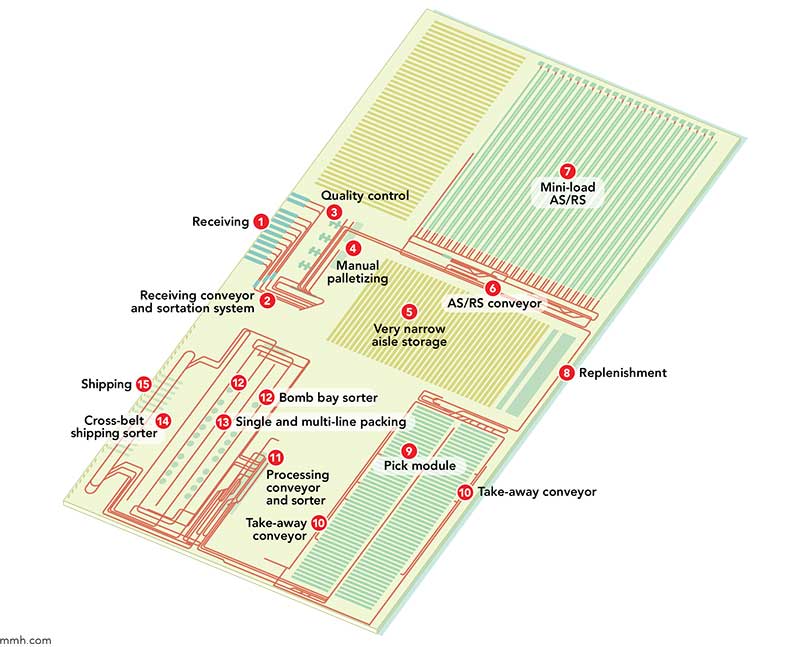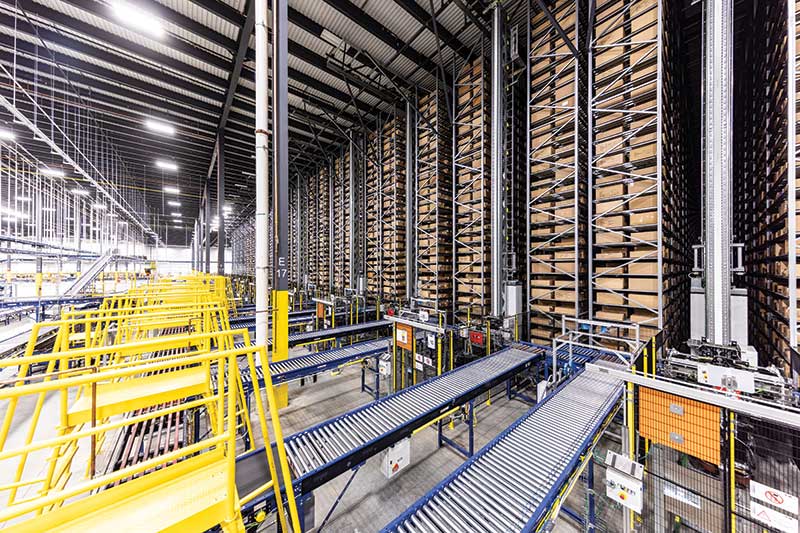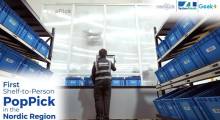Gap Inc.
Longview, Texas
Square Footage: 800,000 square feet
Brands Serviced: Old Navy
Products Handled: Apparel and accessories
SKUs: 100,000 SKUs
Throughput: 500,000 units a day expanding to 1 million units per day in 2023
People/Shifts: Two 10-hour shifts per day/7 days per week. Shifts flex at peak
Gap Inc.’s facilities are highly automated, yet its processes are simple, with a logical flow through the building. The new Longview, Texas, facility is no exception.
Receiving
Gap Inc. calls its receiving process “one touch receiving.” It is also where inventory is inducted into the automation. When a truck or container arrives at receiving (1), associates unload cartons onto extendable conveyors. The cartons then enter the receiving conveyor and sortation system (2), where they are scanned twice using camera-based imaging. The first scan receives the items into the warehouse management system (WMS); then carton dimensions are collected so the WMS can determine the disposition of the carton.
Putaway
Based on the dimensions and condition of the cartons, they can be diverted to one of four areas. The first is a Quality Control area (3). The second is a manual pallet build area (4) for cartons that can’t be handled by the mini-load automated storage and retrieval system (AS/RS) because they’re out of spec or were damaged in transit. Those pallets then go into a very narrow aisle (VNA) reserve storage area that reaches to 35 feet to take advantage of the building’s cube (5). There, pallets are scanned into a storage location. All other inventory will be conveyed (6) to the mini-load AS/RS (7) for very dense, space-saving storage.
Replenishment
Replenishment of the pick modules is initiated by the WMS, based on minimum/maximum levels. Eligible SKUs are retrieved from the mini-load AS/RS or the VNA area and then travel on a replenishment conveyor (8) to the pick module where they are scanned into a pick face.
Picking
Picking is done in the four-level pick module (9). Currently, three levels are used for picking with the fourth available for future expansion. A warehouse execution system (WES) controls the picking process, constantly releasing work to the floor in a continuous flow: As one order is complete, another is released. Associates pick to a tote, using a wearable camera-based imaging device that scans two bar codes in one scan to identify the product and where it should be sent. When the tote is full, it is inducted onto the takeaway line (10) and then enters the processing engine (11) for packing and final disposition.
Packing
In the packing area, the bomb bay sorter (12) sorts items to the correct packing location.
Single line orders are diverted to either a manual pack station or to an automated packaging line (13). Each of the automated lines has 14 pack stations.
Items for multi-line orders eligible for automation are sorted to the robotic putwall area. There, orders are automatically assembled by robotic arms into cubbies. Items that can’t be handled by automation are assembled in manual putwalls. Once assembled, orders are put onto carts and queued up in front of the packers, a process Gap Inc. refers to as decoupled packing.
Shipping
Once orders are packed, they enter the crossbelt shipping sorter (14), where they are then sorted to the right shipping lane.

System suppliers
SYSTEMS INTEGRATION, WAREHOUSE EXECUTION SYSTEM: Vargo
PIECE-PICKING ROBOTIC PUTWALL: Kindred
CONVENTIONAL PUTWALL: Speedpack and Vargo
CONVEYOR AND SORTATION: TGW conveyor and sortation
BOMB BAY SORTER: EuroSort
CROSSBELT SORTER: Interroll
MINI-LOAD AUTOMATED STORAGE AND RETRIEVAL: TGW
AUTOMATED PACKAGING: Accutech
WAREHOUSE MANAGEMENT SYSTEM: Manhattan
BAR CODE SCANNING: SICK (fixed, overhead-conveyor), Cognex on sorter and receiving,
MOBILE COMPUTERS: Zebra Technologies
LIFT TRUCKS: Raymond
AUTOMATIC TRUCKLOADING: FMH Conveyors (BestReach)
WCS - CONTROLS: Matthews (Pyramid)cked, they enter the crossbelt shipping sorter (14), where they are then sorted to the right shipping lane.
Article topics








